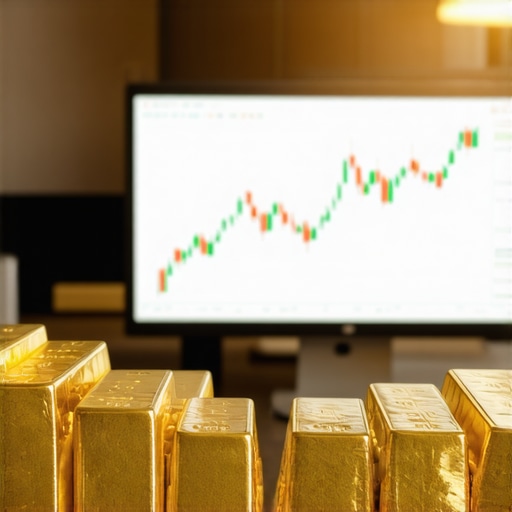Understanding the Gold Market: Timing Your Investment for 2025
Investing in gold has long been a popular strategy for those looking to protect their wealth and diversify their portfolios. However, determining the best time to buy gold can be a complex decision influenced by various economic factors. As we look toward 2025, it’s essential to analyze market trends and forecasts to make informed decisions.
The price of gold is influenced by several key factors, including inflation rates, currency fluctuations, and geopolitical stability. For instance, when inflation rises, gold often serves as a hedge against declining purchasing power, making it an attractive investment option. Investors should keep an eye on the gold price forecast to understand how these factors may affect gold prices in the coming years.
Economic Indicators to Watch for Gold Prices
One of the critical aspects of determining the right time to invest in gold is monitoring economic indicators. The strength of the U.S. dollar, interest rates, and global economic stability all play significant roles in influencing gold prices. A weaker dollar typically results in higher gold prices, as gold becomes cheaper for investors using other currencies.
Moreover, interest rates set by central banks can have a profound impact on gold investments. When interest rates are low, holding gold becomes more appealing compared to interest-bearing assets, thus driving up demand. As we approach 2025, it is crucial to stay updated on central bank policies and their potential effects on gold prices.
Geopolitical Events and Their Impact on Gold
Geopolitical tensions can also lead to fluctuations in gold prices. Events such as wars, trade disputes, and political instability often drive investors toward gold as a safe haven. For example, during times of uncertainty, the demand for gold typically increases, which can lead to higher prices. Keeping an eye on global news and understanding how these events influence the market can help investors decide when to buy gold.
Additionally, understanding gold demand trends is essential for making informed investment decisions. Factors such as jewelry demand, industrial use, and investment demand all contribute to overall gold consumption. For insights into these market dynamics, refer to gold demand trends to anticipate potential changes that may arise in 2025.
Ultimately, timing your gold purchase requires a thorough understanding of various influencing factors. By monitoring economic indicators, geopolitical events, and demand trends, investors can better position themselves to make strategic decisions. As we prepare for 2025, being informed will be crucial for maximizing returns on gold investments.
Analyzing Gold Supply and Demand Dynamics
Understanding the relationship between supply and demand in the gold market is crucial for predicting price movements. In 2025, several factors will shape the supply side, including mining output, recycling rates, and central bank policies. When mining companies face challenges such as rising costs or operational issues, gold supply may dwindle, potentially leading to higher prices. Investors should keep an eye on gold supply forecasts to gauge how these elements might impact their investment strategy.
On the demand side, the consumption of gold in jewelry, technology, and investment plays a pivotal role. For instance, cultural shifts in countries like India and China can significantly influence global demand. To explore these trends further, check out gold demand trends, which provide insights into how these markets will evolve in the near future.
The Role of Interest Rates and Inflation
As previously mentioned, interest rates significantly affect gold prices. When central banks raise interest rates, the opportunity cost of holding gold increases, as investors may prefer assets that yield interest. Conversely, when rates are low, gold becomes a more attractive investment. In 2025, it’s essential to monitor the Federal Reserve’s interest rate decisions and how they correlate with gold price fluctuations.
Furthermore, inflation rates can directly impact gold’s appeal as a hedge against currency devaluation. If inflation expectations rise, investors often flock to gold, driving up its price. Therefore, staying informed about inflation trends will be vital for those looking to time their gold purchases effectively. Refer to gold price forecasts for insights on how inflation is expected to evolve.
Global Economic Trends Influencing Gold Prices
The interconnectedness of the global economy means that economic trends in one region can have ripple effects worldwide. Factors such as trade agreements, international conflicts, and economic growth rates are instrumental in shaping gold prices. For example, a slowdown in economic growth in major economies may lead to increased gold buying as investors seek safe-haven assets.
Additionally, keeping an eye on gold-related ETFs can offer valuable insights into market sentiment. When ETF inflows increase, it typically indicates heightened interest in gold investment. As you prepare for 2025, consider comparing gold ETFs against physical gold investments to determine which aligns with your investment strategy.
Technological Advances and Their Impact on Gold Investments
The technological landscape is also evolving, affecting how gold is traded and valued. Innovations in blockchain technology are creating more transparent and efficient trading platforms, which can influence market dynamics. Understanding these advancements will be crucial for investors looking to stay ahead in the gold market.
As we look toward 2025, it’s worth exploring how technology not only affects trading but also impacts gold mining and processing. For example, advancements in mining technology can lead to more efficient extraction methods, potentially increasing supply. Make sure to keep abreast of these developments, as they may alter your investment outlook significantly.
In summary, making informed decisions about when to buy gold involves a comprehensive analysis of various factors, including supply and demand dynamics, interest rates, global economic trends, and technological advancements. As we approach 2025, staying informed about these elements will enable investors to position themselves effectively in the gold market.
Understanding the Impact of Global Supply Chain Issues on Gold Prices
As we move towards 2025, global supply chain issues are becoming increasingly relevant in the context of gold investments. Disruptions caused by geopolitical tensions, trade disputes, and pandemics can significantly affect gold supply and, consequently, its price. Investors should be aware of these dynamics, as they can create both challenges and opportunities in the gold market.
For instance, when global supply chains are strained, the cost of mining and transporting gold can increase, leading to higher prices. Monitoring these developments will be essential for investors looking to maximize their returns. For more insights on how supply chain issues can affect gold prices, consider reading gold supply and demand insights.
Investment Strategies: Diversifying with Gold
Diversifying your investment portfolio is a crucial strategy for minimizing risks and maximizing returns. Gold can play a vital role in this diversification strategy, acting as a hedge against market volatility. By incorporating various gold investment avenues such as physical gold, gold ETFs, and gold mining stocks, investors can create a balanced portfolio that withstands economic fluctuations.
For those new to gold investing, buying gold can be an excellent entry point. Each investment type has its unique benefits and risks, so understanding these differences will help you make informed decisions. Additionally, exploring top gold investment strategies can provide valuable guidance on how to navigate the market effectively.
The Role of Central Banks in Gold Investments
Central bank policies profoundly influence gold prices and investment strategies. As central banks around the world adjust their monetary policies in response to economic conditions, understanding their actions can provide insights into future gold price trends. For example, if a central bank increases its gold reserves, this can signal confidence in gold as a long-term investment.
Investors should keep a close eye on central bank gold purchases and how they may impact market dynamics. An increase in gold buying by central banks typically leads to an uptick in gold prices, making it an important factor to consider when planning your investment strategy.
Evaluating Gold Mining Stocks: Key Metrics to Consider
Investing in gold mining stocks can be an effective way to gain exposure to the gold market without the need to buy physical gold. However, evaluating mining stocks requires an understanding of specific metrics that can indicate a company’s potential for growth and profitability. Key metrics include production costs, reserves, and the geopolitical stability of the regions where they operate.
For a deeper dive into evaluating gold mining stocks, check out evaluating gold stocks, which provides essential insights for investors. Understanding these factors can help you make more informed decisions about which mining stocks may offer the best returns.
The Future of Gold as an Investment Asset
As we approach 2025, the perception of gold as a safe-haven asset continues to evolve. Factors such as the increasing popularity of cryptocurrency and alternative investments may influence future gold demand. However, gold’s historical role as a store of value and hedge against inflation remains strong, particularly in times of economic uncertainty.
Investors should remain vigilant and explore how emerging trends in the financial landscape may affect gold’s status as a preferred investment. To stay informed, consider examining future gold price trends and how they may shape your investment decisions moving forward.
Understanding the Benefits of Gold ETFs for Investors
Gold exchange-traded funds (ETFs) have emerged as a popular investment vehicle for those looking to gain exposure to the gold market without the complexities of holding physical gold. These funds track the price of gold, allowing investors to buy shares that represent a portion of the gold held in the fund. This offers a liquid and cost-effective way to invest in gold, making it an attractive option for many. As you consider your investment strategy for 2025, it’s crucial to understand the advantages of incorporating gold ETFs into your portfolio.
Investors can benefit from the flexibility of gold ETFs, which can be traded like stocks on major exchanges. This provides the ability to quickly adjust positions in response to market conditions, enhancing your investment strategy. Furthermore, ETFs typically come with lower fees than traditional mutual funds, making them a cost-effective option for long-term investors.
Evaluating Gold Mining Stocks vs. Physical Gold
While many investors are drawn to physical gold, such as bullion or coins, gold mining stocks present another avenue for exposure to gold prices. Investing in mining stocks can offer higher growth potential compared to physical gold, but it comes with increased risk. Understanding how to evaluate gold mining stocks is essential for making informed decisions. Factors such as production costs, reserves, and the geopolitical stability of mining locations should be taken into account. For more insights, check out evaluating gold stocks to determine which companies may present the best opportunities for investment.
The Importance of Keeping an Eye on Global Events
As investors prepare for 2025, staying informed about global events is critical for understanding potential impacts on gold prices. Economic shifts, trade relations, and geopolitical tensions can all influence investor sentiment and gold demand. For instance, escalating tensions between major powers may prompt investors to seek the safety of gold, driving up its price. Monitoring key insights into market trends can help you anticipate how global events may affect your gold investments.
Tax Implications of Investing in Gold
Understanding the tax implications of gold investments is essential for optimizing your returns. In many countries, gold is considered a collectible and may be subject to capital gains taxes at higher rates than standard investments. This could impact your overall profitability, especially if you plan to sell your gold in the future. Familiarizing yourself with local tax regulations regarding gold sales can help you make informed decisions about when to buy and sell.
For those considering gold IRAs, which allow for tax-advantaged gold investments, it’s vital to understand the rules governing these accounts. Accessing expert insights on gold IRAs can provide valuable information on how to navigate the complexities of investing in gold while minimizing tax liabilities.
Future Gold Price Trends to Consider
As we look toward 2025, being aware of the factors that could influence future gold prices is crucial for any investor. Anticipated economic conditions, inflation expectations, and central bank policies will all play significant roles. For instance, if inflation rates continue to rise, gold may become increasingly attractive as a hedge against currency devaluation. For a deeper understanding, explore future gold price forecasts to gain insights into potential trends that could shape your investment strategy.
Frequently Asked Questions About Gold Investments
1. What factors influence the price of gold in 2025?
The price of gold in 2025 will be influenced by various factors including inflation rates, interest rates, geopolitical events, and central bank policies. Monitoring these elements will be crucial for investors looking to time their purchases effectively.
2. How can I invest in gold without buying physical bullion?
Investors can gain exposure to gold through various means, including gold exchange-traded funds (ETFs), gold mining stocks, and mutual funds that focus on gold-related assets. These options provide liquidity and ease of trading compared to holding physical gold.
3. Is investing in gold a good hedge against inflation?
Yes, gold is often considered a reliable hedge against inflation. When inflation rises, the purchasing power of currency declines, making gold an attractive investment for preserving wealth.
4. How do geopolitical tensions affect gold prices?
Geopolitical tensions tend to drive investors toward gold as a safe haven asset. Events like wars, trade disputes, or political instability can increase demand for gold, often leading to higher prices.
5. What are the tax implications of investing in gold?
In many jurisdictions, gold is classified as a collectible, which may subject it to higher capital gains tax rates than typical investments. Understanding local tax regulations is essential for optimizing your returns on gold investments.
6. Can I invest in gold through a retirement account?
Yes, you can invest in gold through specific retirement accounts such as a Gold IRA. This allows for tax-advantaged growth on gold investments, but it’s important to understand the rules governing these accounts.
7. How do I evaluate gold mining stocks?
When evaluating gold mining stocks, key metrics to consider include production costs, reserves, the geopolitical stability of mining locations, and the overall financial health of the company. These factors can indicate potential for growth and profitability.
8. What is the future of gold as an investment asset?
The future of gold as an investment asset remains strong, especially in times of economic uncertainty. While alternative investments like cryptocurrencies may gain popularity, gold’s historical significance as a store of value continues to make it a preferred choice for many investors.
9. How can global economic trends influence my gold investment strategy?
Global economic trends can have significant ripple effects on gold prices. Factors such as trade agreements, economic growth rates, and international conflicts can influence investor sentiment and, subsequently, gold demand. Staying informed about these trends is vital for shaping your investment strategy.
10. What are the advantages of gold ETFs compared to physical gold?
Gold ETFs offer several advantages over physical gold, including liquidity, lower costs, and ease of trading. Investors can quickly buy and sell shares, making it easier to respond to market changes without the complexities of storing and securing physical gold.
Authority Resources for Gold Investment Insights
For those seeking deeper insights into gold investments, consider exploring the following trusted resources:
- World Gold Council – Provides comprehensive reports and insights on gold demand, investments, and market trends.
- Investopedia – Offers educational articles and guides on investing in gold, including strategies and market analysis.
- Kitco News – Delivers real-time gold market data, news, and expert commentary on gold prices and trends.
- Bloomberg Markets – Features financial news and analysis, including updates on gold markets and economic indicators impacting prices.
- Forbes – Publishes articles on investment strategies and market trends, including gold and precious metals.
Conclusion: Making Informed Gold Investment Decisions for 2025
As we look toward 2025, understanding the complexities of the gold market is essential for making informed investment decisions. By analyzing key factors such as economic indicators, geopolitical events, and supply-demand dynamics, investors can better position themselves to capitalize on opportunities within the gold market. Whether considering physical gold, mining stocks, or gold ETFs, staying informed and adaptable will be crucial for maximizing returns on gold investments. With the right strategies and insights, you can navigate the evolving landscape of gold investing and secure your financial future.










The detailed analysis on timing gold investments for 2025 really highlights how multifaceted this decision can be. What stands out most to me is the interplay between inflation rates and central bank interest rate policies. From what I’ve observed over the last few years, gold tends to react sharply when central banks shift their stance, especially as the U.S. dollar weakens. It’s interesting that the article notes how low interest rates increase gold’s appeal by reducing the opportunity cost compared to interest-bearing assets. Personally, I’ve found staying updated on central bank announcements and inflation data to be invaluable when deciding whether to enter the gold market.
One aspect I think deserves more attention is how technological advances, particularly in mining efficiency, could influence supply and thus price dynamics going into 2025. Improved extraction methods might ease supply constraints just as demand from emerging markets rises.
I’m curious to hear from others: how do you balance watching economic indicators with geopolitical developments when deciding your timing for gold investments? Do you prioritize one over the other, or is it more about their combined impact? Also, how do you integrate emerging technologies and market innovations into your investment outlook?